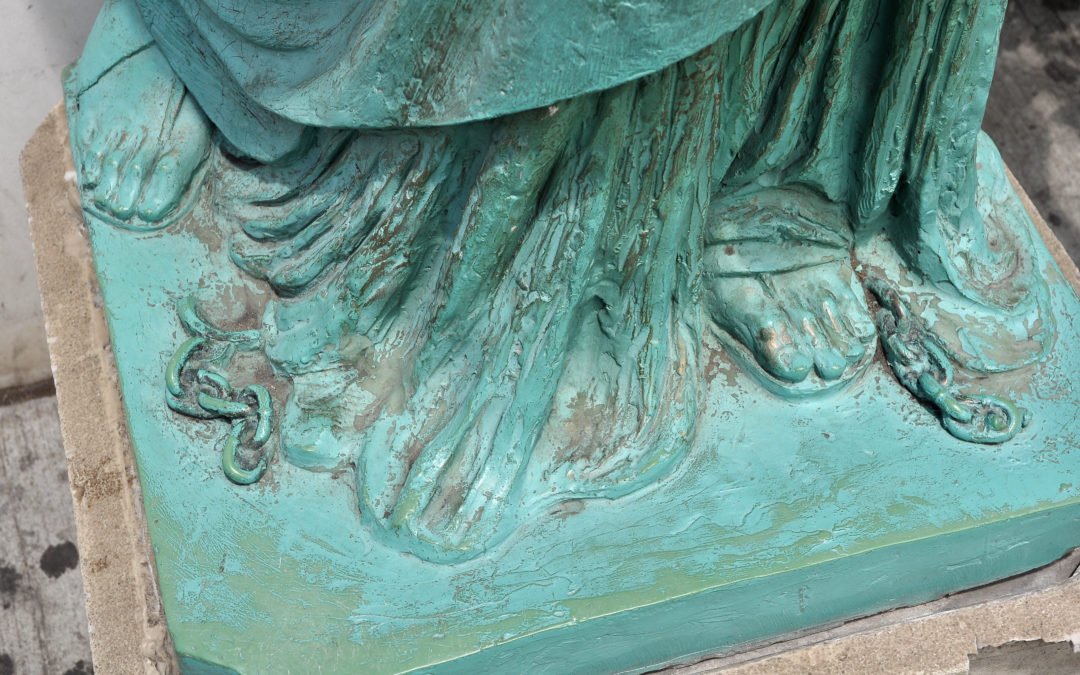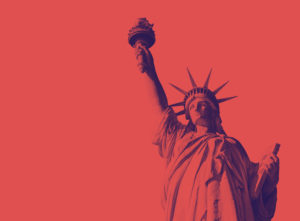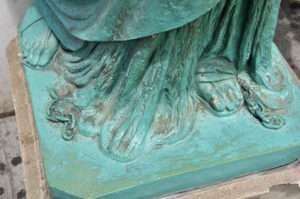
by Denise Anita Hill | Jun 27, 2023 | Black History, Commentary, Headline News |

“Liminal” is defined as the space between. It is the no-longer before, and the not-yet other. It is the space where we find ourselves caught between the light of Juneteenth and the shadow of July 4th. We are caught in the space between. No longer enslaved on plantations, but not yet with a freedom fully realized. It’s an imaginative space; an emergent space; and a space for reflection.
It is in this space that I am reminded of the Statue of Liberty, and the broken chains at her feet. I first learned about the chains in 2017, at a training in Chicago led by Dr. Joy DeGruy. She told the story of how the chains were part of the original vision of the statue, how American financiers insisted that the chains be removed, and how the sculptor still managed to sneak the chains in under Lady Liberty’s garments, lying broken at her feet. She told the story how the National Park Services didn’t talk about the chains unless someone happened to ask. The chains were not part of the Park Services’ narrative about the Statue. In the Statue’s 135-year history, information about the chains have only officially been included in the park service’s literature and website for about the past six years.

Yasmin Sabina Khan goes even deeper in her work, “Enlightening the World: The Creation of the Statue of Liberty.” Conceived in 1865 by Édouard de Laboulaye, sculpted by Frédéric-Auguste Bartholdi over the course of approximately 20 years, the Statue of Liberty was unveiled at New York’s Ellis Island as “Liberty Enlightening the World” in October of 1886. At the base of the Statue, out of view from anyone looking from ground level, lie the broken chains of slavery. Visible only from helicopter or drone, the chains weren’t spoken of. Laboulaye was an ardent abolitionist. With the end of the US Civil War in 1865, Laboulaye imagined a gift that would embody the significance of the liberation of those who were enslaved. Bartholdi’s original model placed the torch of liberty in one hand, and broken chains in the other. The Statue of Liberty’s entire visual and artistic vocabulary was meant to both celebrate and honor the freedom of those enslaved in America. But financiers balked at the idea of chains placed anywhere on the Statue, and after profuse opposition by Bartholdi, the chains were removed, replaced by a tablet emblazoned with the Roman numerals for July 4, 1776. Since they aren’t easily visible, and since there was no concerted public effort to connect the statue with the narrative of the abolition of chattel slavery, the memory of it’s connections faded. And for the past 135 years, barely anyone remembered the chains.
For Black people within this liminal march of history, the Statue has long sat as a symbol of hypocrisy—celebrating a freedom that became connected to a honoring of ideals that have yet to be realized. There’s much to unpack about our historical reactions to the unveiling of the Statue, but there’s also much to be said about the loss of memory. The obscuring and loss of communal memory around the presence, history, and meaning of the chains at the feet of the Statue of Liberty is important because it reminds us that memory is important. And not only is memory important, memory is crucial in this liminal space between freedom and freedom. Memory is what helps us imagine. Memory is what helps us create. It’s something we can use to construct and define a new world, a new freedom, a new way of being. We must tap into it.
In his book, “Something Torn and New: An African Renaissance” Ngugi wa Thiong’o writes, “creative imagination is one of the greatest of re-membering practices…” and that “memory is the link between the past and the present, between space and time, and it is the base of our dreams.” Harnessing memory is our work. These broken chains at our feet, the light of Juneteenth, the long shadow of July 4th—this liminal space—all of it is here to remind us that we have worlds to build. We have a freedom to define—to make clear and meaningful. It is within this creative tension where we have the possibility to gain a clear-eyed view of what a full realization of freedom could look like, both collectively as a community and a country, and particularly in the living out of our individual lives and individual situations. But understand, there can be no clear expression of freedom without integrating communal memory into the foundation of work.
If memory is the base of our dreams, what are our dreams of freedom? What if we could transform freedom in the same ways that we’ve always transformed culture? In this liminal space of history, we’ve seen Black creativity, Black genius, Black art, and Black joy shift and drive culture (and economies) around the world. Have we fired that same ingenuity in our definitions of freedom? What would the world look like, if we defined and constructed freedom based on our criteria, our imaginations, our memory? It might look something like a society built on the idea of thriving rather than destruction. It might look something like a society built around dignity—of humans, animals, and the earth. It might look something like systems built to nourish and sustain life rather than profit. Freedom could look like so many different visions of more and better. The dreaming is up to us.
We have work to do. We have worlds to build. We have a freedom to create. And as we go about protesting and advocating for our lives, here in this liminal space between freedom that was and freedom that might yet be, may we remember that the work we have to do, the worlds we are building, and the freedom we are creating, cannot reach their fullest expression without our communal memory.
Let us remember the chains broken at our feet, so that we may creatively continue in our generation’s leg of the journey toward the light of freedom fully realized.
by Karissa Braxton | Jun 24, 2016 | Feature |
The sun is out and barbecue grills are fired up. The long-awaited summer season has returned. With longer days and hotter temperatures, everyone is filling their social calendars with vacations, local events, and outside activities to make up for time spent indoors during those dreaded winter months. We’ve put together a list of summer ideas that are sure to make this season one to remember.
1) Pick a Concert

What better way to enjoy the summer than attending concerts and music festivals. Major artists such as; Kirk Franklin, Beyoncé, Tina Campbell , Drake, Adele and many more will tour across the nation creating the perfect night out for fans everywhere. Many cities will also host music festivals, some that are nationally sought after and others that are local jewels. Newark Folk Festival, Made in America and Essence Music Festival are but a few of the many music events that parks and waterfronts across the nation will host.
2) Book a Vacation
Memorial Day Weekend and Labor Day mark the beginning and end of the summer travel season. It is during this time that parents save vacation days for exciting family trips while kids are on break. These months also provide the perfect opportunity to take a girl’s trip, guy’s trip, plan a wedding, or explore a new city solo. This summer, set aside some time and plan a trip that fits your budget to gain experiences and make memories that are priceless. Travel to a new country and absorb the local culture. Visit a new and exciting city. Find time for some rest and relaxation away from the hustle and bustle of the regular work and school week. Now may be a good time to add new stamps to your passport.
 3) Explore Your City
3) Explore Your City
How well do you know your state, City or Neighborhood? The U.S. is full of popular, as well as less known, treasures unique to each state. Busy work, school, and family schedules often do not allow time to just be a tourist in our own backyards. This summer, take some time to explore the place you call home. Not sure where to go? Look up your state’s national parks, beaches, museums, campsites, community events and other tourist attractions for ideas on how to better enjoy your state.
4) Spend Some Quality Time
Summertime is the perfect opportunity to spend much-needed quality time with family, friends, and yourself. Whether you’re building your vacation around a family reunion, or picking out the best spa package for you and the girls, don’t let this summer pass without reconnecting with those that matter the most.
 5) Take Up a Hobby
5) Take Up a Hobby
Have you ever wanted to try something new but can’t find time to do so? With longer days and warmer weather, find some time to pick up a new hobby. Group activities such as sip and paint classes have become increasingly popular for those that want to explore their artistic side. And for those that are interested in fitness, activities such as Destination Fit-Trip provide the opportunity to travel to a new country and participate in group fitness workouts with popular personal trainers. Hobbies can be expensive, however, sites such as Living Social and Groupon allow you to search for various activities at a discounted rate and participate in different types of experiences.
6) Work on Special Projects
Special projects, such as home improvement, are a huge task to undertake both physically and financially. Whether you’re completing the project yourself, or contracting outside help, this summer could be the perfect time to remodel that kitchen or bathroom, add the extra bedroom to the house, or re-do the deck just in time for barbecues. If special projects will be the task of the summer, make sure you utilize Fourth of July sales to save costs on supplies, and complete the work before the season changes.
Do you have any other great ideas to add to the list? Share them with us below.
by Jacqueline J. Holness | Jun 17, 2016 | Commentary |
With the release of films such as 12 Years a Slave and The Birth of a Nation and the re-make of the “Roots” mini-series in 2016, we have seen our fair share of the history of black slavery. However, the past few years may have marked the beginning of a burgeoning interest of millennials and younger in exploring slavery, the eventual emancipation of slaves and beyond.
While the official date of the Emancipation Proclamation freeing slaves was enacted on Jan. 1, 1863, it would take two years for slaves in Galveston, Texas to learn of their freedom on June 19, 1865 when Union General Gordon Granger arrived in the city and told them they were free. In years since, June 19 began to be celebrated across the country as Juneteenth and in 1980, the Texan legislature established Juneteenth as a state holiday. Still, the celebration of Juneteenth, which has been inconsistent throughout the course of history, has yet to achieve the recognition and popularity of other official American holidays.
Rev. Ronald V. Meyers Sr., chairman of the National Juneteenth Observance Foundation, has been working since 1994 when he helped organize the foundation that is working to have Juneteenth recognized as a national American holiday. “Forty-five states recognize Juneteenth as a state holiday or a special day of recognition or observance. We’re still missing North Dakota, South Dakota, New Hampshire, Montana, and Hawaii,” says Meyers.
Myers learned about Juneteenth through celebrations in his hometown of Milwaukee, Wisconsin. “We had one of the largest celebrations around and it was then that I began to understand the history of our freedom in America, and I took that with me wherever I went.”
By 1994, Myers, who was living in Louisiana then, met with Juneteenth enthusiasts from across the country at Christian Unity Baptist Church in New Orleans. He was selected to be the chairman of National Juneteenth Observance Foundation at the meeting. “We wanted to work together for greater recognition of Juneteenth to make it like Flag Day and have a day set aside for the celebration.”
While Myers has been successful in securing senate resolutions in 2014 and 2015, designating June 19 as Juneteenth, he had hoped to gain former President Barack Obama’s support of Juneteenth by his last year in office.
“When President Obama was a state senator in Illinois, he supported legislation to officially recognize Juneteenth in 2003. And when he was a U.S. senator, he sponsored legislation to recognize Juneteenth in the U.S. Senate in 2006. But he hasn’t issued a proclamation to make Juneteenth Independence Day a National Day of Observance as president or held a Juneteenth celebration at the White House. I don’t know why since the White House was built by slaves.”
While Obama did not issue a proclamation, he did issue a statement on June 19, 2015 supporting the observance of Juneteenth which was posted on the White House website. He also referenced the shooting at Emanuel A.M.E., which occurred a year ago on June 17. To read the statement, click here.

The home of author and illustrator Floyd Cooper’s great-grandparents who were slaves. (Photo Courtesy of Floyd Cooper)
Similarly to Meyers, Floyd Cooper, children’s book author and illustrator, remembers celebrating Juneteenth in Haskell, Oklahoma where he grew up. “I’m from a very large extended family, and all of my cousins, aunts, uncles and everyone would get together and have big cookouts for Juneteenth.”
He also remembers hearing about his family’s history from his great-grandparents who were freed slaves and lived in a home built from stone in Oklahoma. They migrated to Oklahoma after packing up in a covered wagon and leaving Texas. Before that, they moved from Georgia where they worked as slaves on a plantation owned by an Irish man. “They said he never whipped them which was important for them,” Cooper says.
His great-grandparents also kept a photograph of one of their slave ancestors from Georgia in their home. “I remember being a child looking up at that photograph. It was in one of those oval frames.”
While he hasn’t been able to link his great-grandparents directly to the slaves who heard about the Emancipation Proclamation on June 19 in Galveston, Texas, he did draw from his own family’s history to write and illustrate Juneteenth for Mazie, a children’s picture book of the history of Juneteenth which was published in 2015 .
In the book, Mazie’s father teaches young Mazie about the struggles and the triumphs of her family’s past as they prepare to celebrate Juneteenth. “Juneteenth is a great American holiday,” Cooper says.
However, some are not in favor of celebrating nor recognizing Juneteenth. Ronda Racha Penrice, author of African American History For Dummies, is one of those detractors.
“[Juneteenth] reinforces Black people as passive and as people waiting for others to free them when black people in the South would tell Union soldiers when they showed up that they were free and come and set up camp with Union soldiers,” Penrice says. “Many of them wrote letters to the White House for instructions as to what to do. This influenced the drafting of the Emancipation Proclamation.”
Penrice also doesn’t believe that June 19 is a particularly special day as slaves throughout the South became aware of their freedom on different days.
“Emancipation Day celebrations took place May 8 for some and August 8 for others.” Penrice also pointed out in her book that many of the celebrations stopped after 1920 when black people moved to larger cities and wanted to disassociate from their rural pasts.
However, while Meyers agrees that slaves learned about their freedom on various days, he still believes that freedom from slavery should be celebrated.
“My challenge to African Americans is ‘What day do you celebrate our freedom?'” he says. “On the 4th of July when Americans of African descent were still caught up in the tyranny of slavery?”
Do you and the people you know observe Juneteenth? Why or why not? Sound off below.





 3) Explore Your City
3) Explore Your City 5) Take Up a Hobby
5) Take Up a Hobby